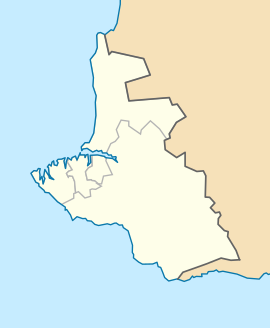
Back تاوريس خيرسون Arabic Херсанес Таўрычаскі Byelorussian Хэрсанэс Таўрыйскі BE-X-OLD Херсонес Таврически Bulgarian C'hersones Breton Taurijski Herson BS Quersonès Catalan Hersones CRH Chersonésos Czech Chersonesos Danish
Χερσόνησος Херсонес | |
 St. Vladimir's Cathedral overlooks the extensive excavations of Chersonesus. | |
| Alternative name | Chersonese, Chersonesos, Cherson |
|---|---|
| Location | Gagarin Raion, Sevastopol |
| Region | Taurica |
| Coordinates | 44°36′42″N 33°29′36″E / 44.61167°N 33.49333°E |
| Type | Settlement |
| Part of | National Preserve "Khersones Tavriysky" |
| Area | 30 ha (74 acres) |
| History | |
| Builder | Settlers from Heraclea Pontica |
| Founded | 6th century BC |
| Abandoned | Around 1400 AD |
| Periods | Classical Greece to Late Middle Ages |
| Cultures | Greek, Roman, Hunnic, Byzantine |
| Site notes | |
| Excavation dates | 1827 |
| Management | The National Preserve of Tauric Chersonesos |
| Website | www |
| Official name | Ancient city of Tauric Chersonese |
| Part of | Ancient City of Tauric Chersonese and its Chora |
| Criteria | Cultural: (ii), (v) |
| Reference | 1411 |
| Inscription | 2013 (37th Session) |
| Area | 42.8 ha (0.165 sq mi) |
| Buffer zone | 207.2 ha (0.800 sq mi) |
| Website | chersonesos-sev |
Chersonesus (Ancient Greek: Χερσόνησος, romanized: Khersónēsos; Latin: Chersonesus; modern Russian and Ukrainian: Херсоне́с, Khersones; also rendered as Chersonese, Chersonesos, contracted in medieval Greek to Cherson Χερσών; Old East Slavic: Корсунь, Korsun) is an ancient Greek colony founded approximately 2,500 years ago in the southwestern part of the Crimean Peninsula. Settlers from Heraclea Pontica in Bithynia established the colony in the 6th century BC.
The ancient city is located on the shore of the Black Sea on the outskirts of present-day Sevastopol on the Crimean Peninsula, where it is referred to as Khersones. The site is part of the National Preserve of Tauric Chersonesos. The name Chersonesos in Greek means "peninsula" and aptly describes the site on which the colony was established. It should not be confused with the Tauric Chersonese, a name often applied to the whole of the southern Crimea.
During much of the classical period, Chersonesus operated as a democracy ruled by a group of elected archons and a council called the Demiurgoi. As time passed, the government grew more oligarchic, with power concentrated in the hands of the archons.[1] A form of oath sworn by all the citizens from the 3rd century BC onwards has survived to the present day.[2][3] In 2013 UNESCO listed Chersonesus as a World Heritage Site.[4]
- ^ Cite error: The named reference
EB1911was invoked but never defined (see the help page). - ^ "Syll. 360: The oath of the citizens of Chersonesos". attalus.org. Archived from the original on January 19, 2018. Retrieved May 20, 2015.
- ^ Vladimir F. Stolba, The Oath of Chersonesos and the Chersonesean Economy in the Early Hellenistic Period, in: Z.G. Archibald, J.K. Davies & V. Gabrielsen (eds.), Making, Moving and Managing. The New World of Ancient Economies, 323-31 BC. Oxford: Oxbow 2005, 298-321.
- ^ Claus, Patricia (2022-12-01). "Ancient Greek City of Chersonesus in Crimea Founded 2,500 Years Ago". greekreporter.com. Retrieved 2023-05-09.
© MMXXIII Rich X Search. We shall prevail. All rights reserved. Rich X Search


